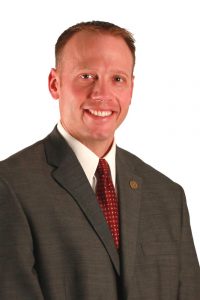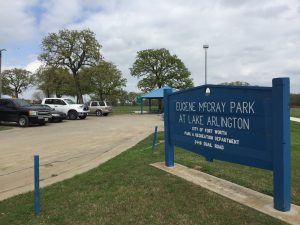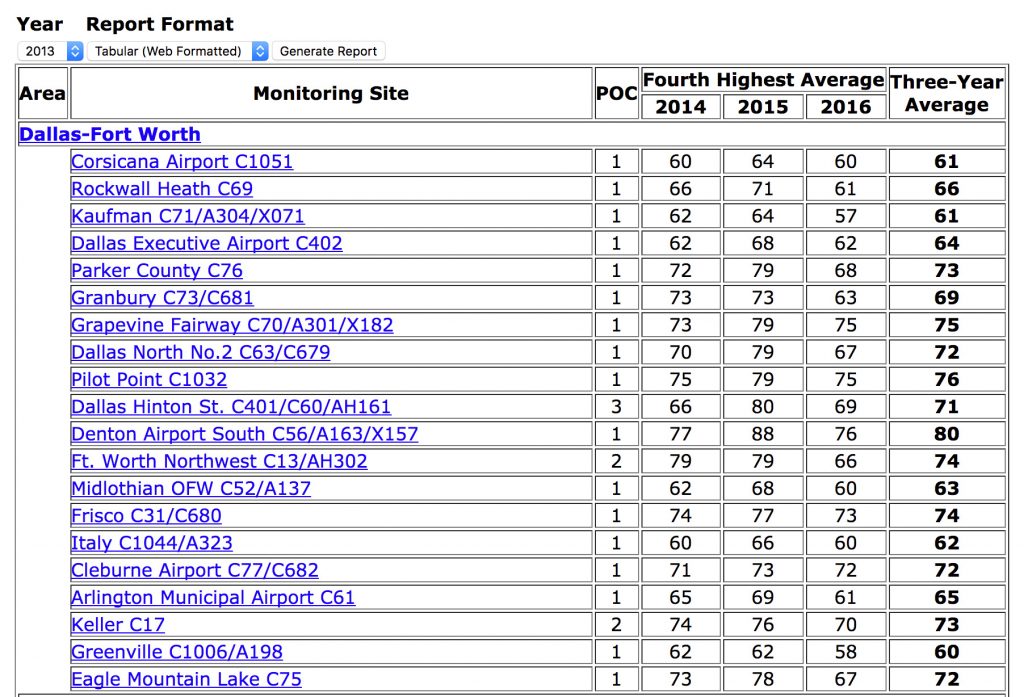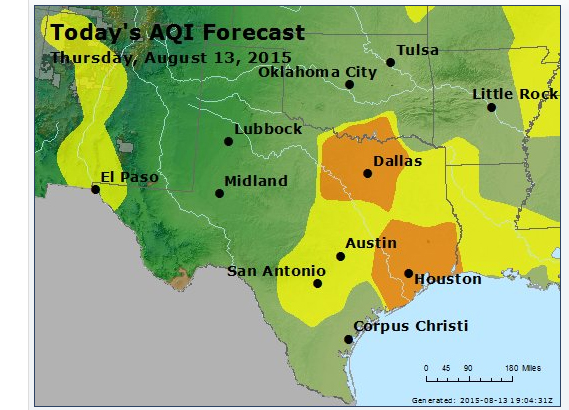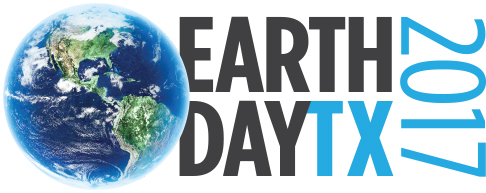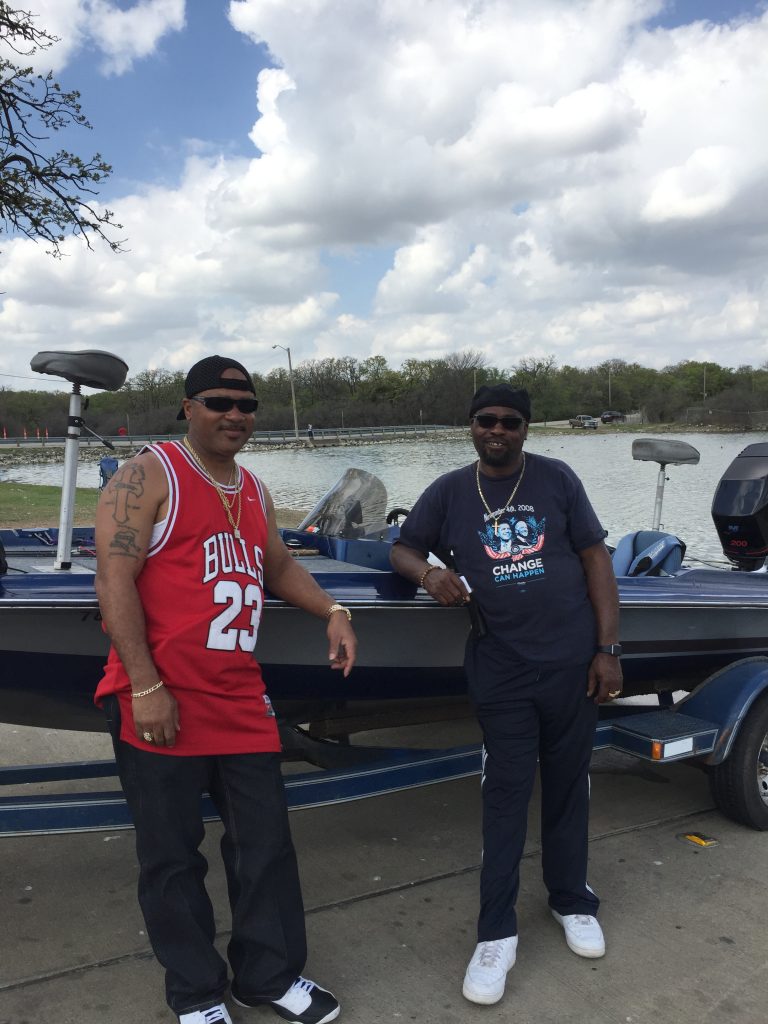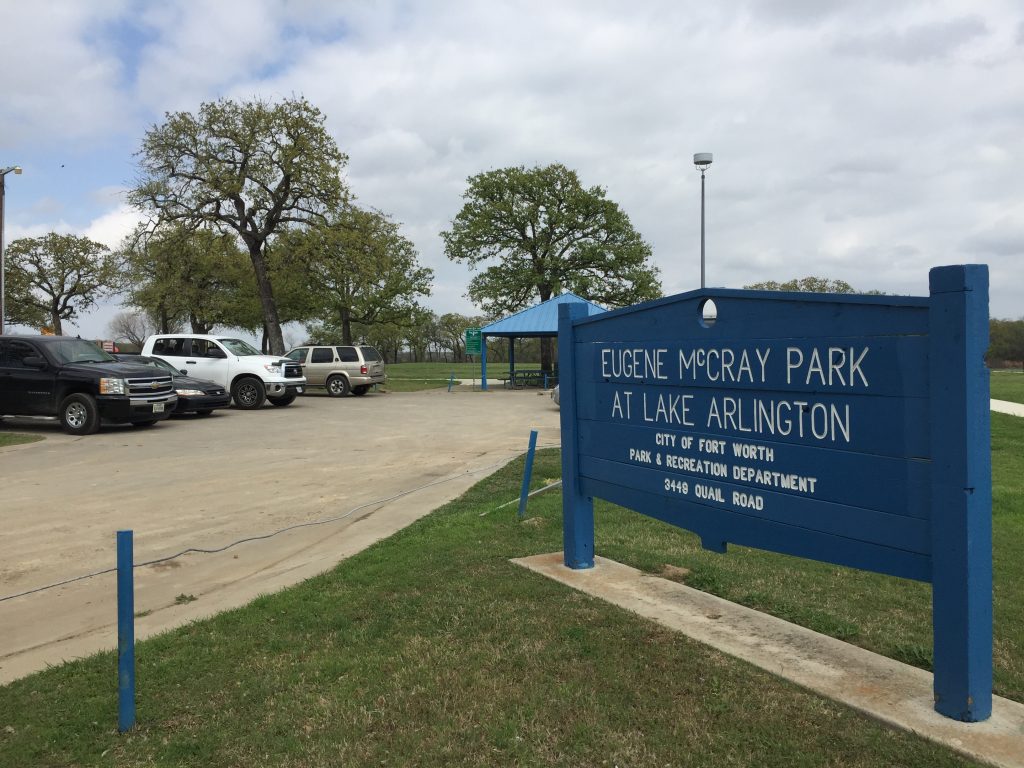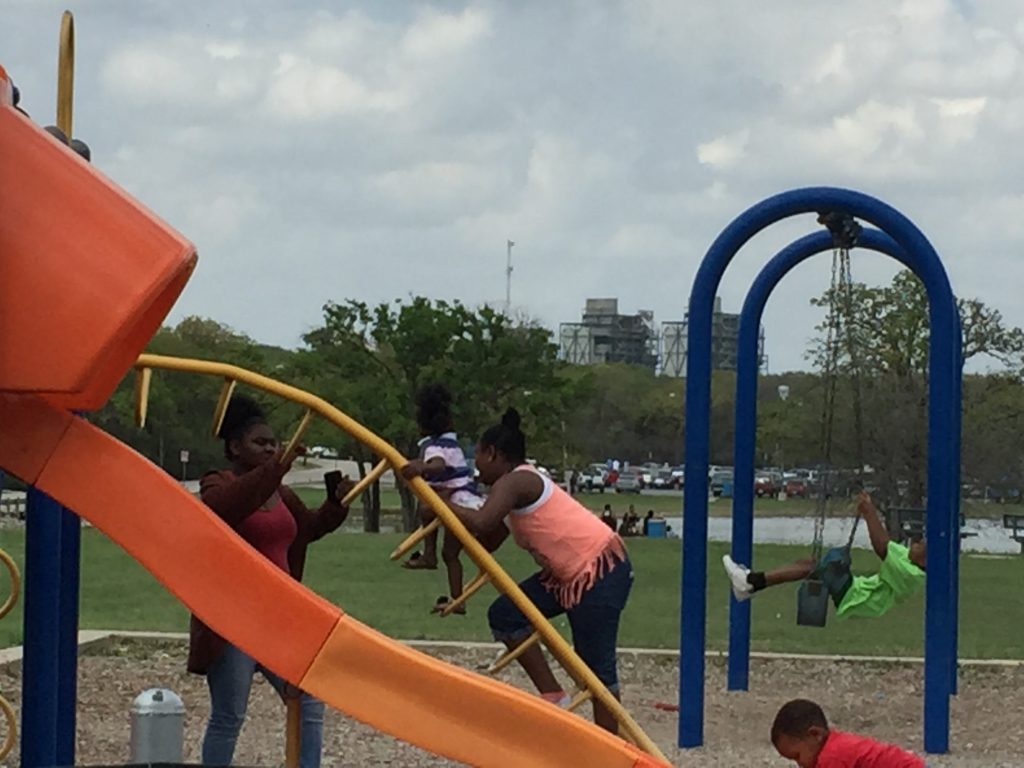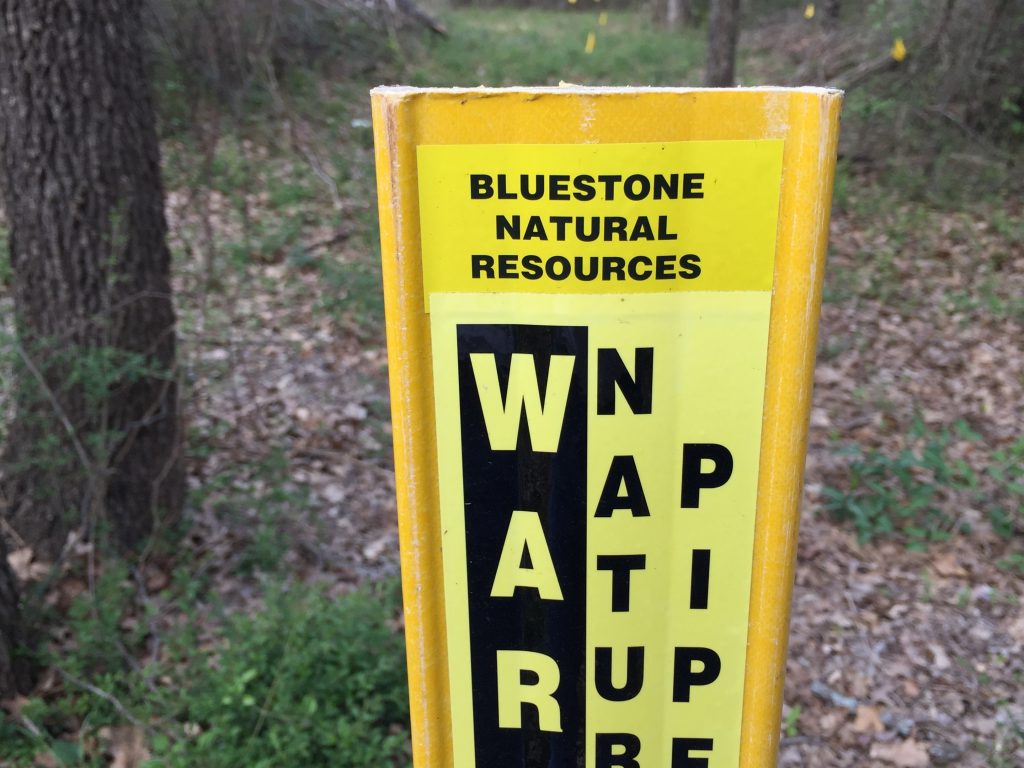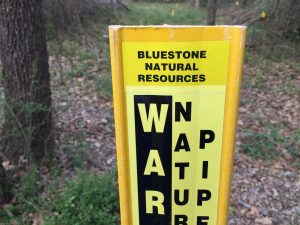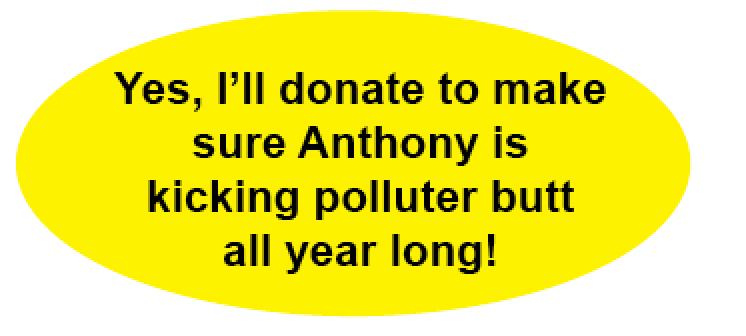Citizen Action
Next Week Gives You Two Chances to Press RRC Commissioner on Lake Arlington Injection Well
Texas Railroad Commissioner Ryan Sitton in DFW Next Week
Thursday Night, April 20, 2017 6:00 PM – 8:00 PM
Community Forum about: Injection Disposal Wells
Handley Meadowbrook Community Center
6201 Beaty St, Fort Worth, TX 76112
Sponsored by St. Rep Nicole Collier
Friday Morning, April 21st, 10:50 – 11:40 am
Responsible Shale Extraction Roundtable Discussion
Automotive Building, Earth Day Texas at Fair Park
Open, public, and free appearances in DFW by Texas Railroad Commissioners these days are about as rare as actual trains at the RRC. But this next week offers two chances for local residents to see, hear, and talk to a real Commissioner without having to donate money to his campaign.
Irving’s own Ryan Sitton, RRC Commissioner since 2014, will be in town for two free public forums on consecutive days on either side of the Metromess: Thursday night at a community meeting in Southeast Fort Worth and Friday morning at an Earth Day Texas appearance at Fair Park.
That’s important because Sitton is one of only three RRC votes that could decide to take the unprecedented action of permitting a huge fracking waste injection well on the shores of Lake Arlington, source of drinking water to hundreds of thousands, and just a short distance from Eugene McCray Park, one of the most popular recreational spots for Fort Worth’s black community.
On Thursday from 6 to 8 pm, at the Handley Meadowbrook Community Center, Sitton will be the featured guest of a forum on the injection well sponsored by State Representative Nicole Collier, who represents Stop Six.
On Friday morning, from 10:50 to 11:40 am Sitton will be one of four participants in a Earth Day Texas roundtable discussion at Fair Park on “Responsible Shale Extraction” as part of UTA’s C.L.E.A.R. ambitious two-day symposium on the oil and gas industry within the weekend extravaganza. Also on the Earth Day panel are UTA’s Dr. Kevin Shugg, Director of CLEAR, Laura Buchanan, who’s the Director of the Texas Land and Mineral Rights Association, and Downwinders’ own Jim Schermbeck.
Sitton spent his early career working for the oil and gas industry, including ALCOA, Oxy, Marathon, and Berwanger Engineering and Consulting. In 2006, he and his wife founded PinnacleART, an engineering consulting company. Like all of his peers, his 2014 campaign was primarily financed by individuals and corporations he’s now in charge of regulating.
The threat to Lake Arlington has brought opposition from a host of cities who get some or most of their drinking water from the reservoir, including the City of Arlington and Grapevine, while earning Fort Worth’s outrage by challenging a pre-HB40 ban on such wells in the city limits. Back in 2015, Cowtown’s oil and gas drilling-friendly ordinance was touted by the industry as a model. It only took two years for the industry to decide it wanted an even more lenient code of conduct – one that would allow over a million gallons of fracking waste to be injected daily at high pressure into fissures directly under Lake Arlington.
Bluestone’s blatant provocation has produced an alliance between fractivists, environmentalists, Stop Six residents, and municipalities like Fort Worth that was unthinkable in 2015.
These two appearances by Sitton are likely one of the only opportunities most DFW residents will get to voice their opposition to the injection well to a RRC Commissioner in person before the May hearing September hearing on the permit.
The two-day hearing before the entire RRC will take place in Austin, not Arlington or Ft. Worth, and after that, no matter the ruling, the feeling is that all of this is going to be in court for a while. So please spread the word and use Thursday and Friday to make sure Commissioner Sitton knows exactly how local residents feel about the Bluestone permit.
You can also still use our Featured Citizen Action link send an email to the RRC protesting the injection well.
Make no mistake about it, the decision the RRC makes about this in-your-face industry confrontation with Fort Worth – whether even a “model” ordinance can withstand the rapacious regulatory rollback currently underway within federal and state government, is going to be a landmark one affecting every city in Texas. Don’t sit it out.
There’s Exactly One Full Time Clean Air Group in DFW. Please Help Us Keep It In Business.
Now that another ozone season is beginning, it’s time to remind you that Downwinders is still the only group exclusively devoted to the issue of cleaner air in Dallas-Fort Worth – an area that hasn’t been in compliance with the Clean Air Act since 1991.
Hard to believe on both counts, but it’s true.
It doesn’t matter whether it’s the Barnett Shale gas patch, the Midlothian cement plants, or the East Texas coal plants, we take on whoever and whatever is polluting DFW air.
Downwinders is the only group in DFW with a staff devoted to working on clean air issues full time. We provide the eyes and ears at daytime meetings and hearings volunteers can’t attend. We provide citizens with arms and legs to help do research and network among allies.
Downwinders does all this without the help of a home office in Austin or Washington or New York. We’re completely local, with a board composed of concerned DFW residents just like yourself. Your donations get spent on field work in North Texas.
We’re smaller than our state and national peers but our track record proves we can have a big impact. In fact, with your help, we’ve become known for being one of the most effective environmental groups in the state, no matter the size.
The operative words being “with your help.”
Without the steady stream of contributions from citizen supporters like yourself every year, we wouldn’t be able to keep staff in the field. We wouldn’t be able to dispute the state’s bogus claims of no harm from smog, or hold the EPA accountable.
We wouldn’t be able to host our annual Root and Branch Revue for grassroots activists, or run fruitful experiments like the College for Constructive Hell-Raising.
We know things are looking grim now. But imagine how much worse it could be without a Downwinders at Risk looking out on behalf of your lungs.
Thanks for your consideration.
Have You Seen Me? The Missing DFW Clean Air Plan
 Somewhere deep in the cubicled bowels of the Region 6 EPA offices in downtown Dallas lies a draft of a letter to the State of Texas telling Austin it’s proposed clean air plan for DFW is inadequate and must be re-written.
Somewhere deep in the cubicled bowels of the Region 6 EPA offices in downtown Dallas lies a draft of a letter to the State of Texas telling Austin it’s proposed clean air plan for DFW is inadequate and must be re-written.
It likely goes through the litany of well-known public objections the EPA has about the plan, originally expressed while it was being drafted by the Texas Commission on Environmental Quality:
- The state’s computer air modeling’s predictions of drops in pollution are “unrealistic.”
- The state’s plan doesn’t do anything about pollution from the old East Texas coal plants despite evidence “strongly supporting” the link between their poisons and DFW smog.
- Air quality monitors in the gas patch are lagging behind other DFW area monitors in showing decreases in smog over the last decade, indicating pollution from gas patch facilities is slowing air quality progress, but the state’s plan doesn’t reduce it either.
- Despite a brand new state-of-the-art pollution control system that could cut smog pollution by 70-90% being voluntarily installed at one cement kiln in Midlothian, the state is not requiring the other three kilns install the same technology.
Which is all longhand for “this plan is not cutting enough air pollution to work.”
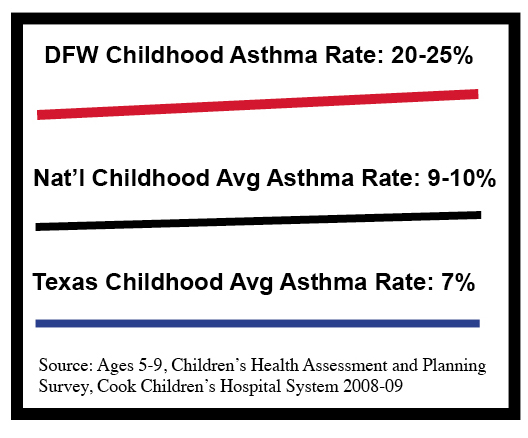 The current standard for smog, or ozone pollution, is 75 parts per billion over an eight hour period. That’s supposed to come down to 70 in the next few years as a new, more protective federal standard is applied.
The current standard for smog, or ozone pollution, is 75 parts per billion over an eight hour period. That’s supposed to come down to 70 in the next few years as a new, more protective federal standard is applied.
DFW’s eight hour average is 80 parts per billion at the start of this “ozone season.” (based on the numbers coming out of the Denton air quality monitor) The North Texas region has never been in compliance with the smog standard, even when it was 120 parts per billion over just an hour. That’s 26 years of bad air and counting.
The state’s plan is supposed to be response to this problem, but for the second time in a row, Texas has written an air plan for DFW that does nothing at all.
Before November, that plan was going to be rejected, in part, or whole, as insufficient by EPA, sent back to Austin for a re-write and then, fingers crossed, Downwinders and others were hoping to persuade the Agency to substitute its own federal plan of action. That would have been a first for DFW.
In December, Dallas County Commissioner Dr. Theresa Daniel, Dallas Council member Sandy Greyson, Dallas Mayor Mike Rawlings, staff representing Congresswoman Eddie Bernice Johnson and Congressman Marc Veasey, members of the Dallas County Medical Society and Downwinders members all pleaded with EPA Regional Administrator Ron Curry to try and persuade him to reject the state plan and implement a federal one before Inauguration Day.
Curry’s response was to say that timeline was too fast – despite having had the state plan in-house at EPA for over a year, and access to its conclusion for even longer. Plus, he said reassuringly, they’d all gone through “transitions” from one administration to another. Everything would be all right.
Donald Trump will not be able to revive the coal industry. He will not be able to revoke President Obama’s climate change policies en masse without court fights. Meta national and international trends are beyond his gutted EPA’s reach to impact. But he can keep seven million DFW residents from breathing safe and legal air for the next decade.
Right now, the state clean air plan for DFW is still parked at EPA. Because of the change in administrations, the staff is probably being told to do the math twice and make only the most conservative calls. That may mean rejecting only certain parts of the plan, albeit critical ones, like the section that promises to get down to 75 ppb by the end of this summer.
Yes, that was the original goal of the plan way back when it started being put together in 2014-15. If we have another cooler, wetter summer it’s possible we could get close. If we have a typical DFW summer, the smog might get worse, as it did the last time a state clean air plan that did nothing was being implemented in 2011.
Besides rejecting the “attainment” part of the attainment plan, the EPA could also reject the way the state defined new control technologies as impractical or too costly despite being widely used in industry. One example is electrification of compressors in the gas patch. Even the gas and oil’s industry’s own textbooks cite this one simple switch in power sources, from diesel or gas to electricity to power huge, locomotive size pipeline compressors, as being the standard fix in metropolitan areas with bad air.
But the state’s rejecting requiring electrification because it says it just isn’t practical to expect that those compressors can find power close enough to the grid to plug-in….in the fourth largest urban area in the country.
Another example are the three Midlothian cement plants, still the single largest sources of air pollution in DFW.
One cement plant operator has voluntarily installed what’s considered to be a state-of-the art pollution control system that’s capable of reducing smog-forming emissions by 70-90%. This system is also being used with great effect in Europe on almost a dozen plants. But the state’s plan doesn’t take note of this sea-change in technology and doesn’t require the other three cement plants in Midlothian to install it, saying it hasn’t been proven yet – even though it’s in full scale operation in a Texas cement kiln right now.
But while the local EPA staff may have felt more confident about making those calls on new pollution controls in a Clinton administration, it’s unlikely they’ll advocate for them now, knowing their new bosses in DC will not approve.
So they’ll put a big’ ol “REJECT” stamp on the state’s paperwork and and send it back to Austin for a redo.
From where it will never see the light of day again.
Officially, when the EPA rejects a state clean air plan, it triggers a two-year deadline to come up with another one. So normally, the state would go through the motions and eventually churn out another plan, it would be found inadequate by EPA again, the whole thing would wind up in court and either the EPA and/or environmentalists would win some concessions.
But the EPA is transitioning from one smog standard to another. There’s a gap in enforcement of the old standard to get ready for the new one. So the State of Texas, which hasn’t even tried to write a serious clean air plan in decade, and doesn’t even believe smog is bad for you, will get a Mulligan from the EPA for not being able to produce a clean air plan for DFW that works.
Not only will the state of Texas not be penalized for writing an ineffective clean air plan, but if DFW is still not in compliance with the older 75 ppb smog standard by the end of this summer, it won’t be penalized for that either. Because now the EPA is switching over to the 70 ppb standard – and there are brand new deadlines for brand new clean air plans….for the State of Texas to willfully ignore.
Greg Abbott will not be punished for ignoring the law. The Texas Legislature will not be punished. Nobody at TCEQ will pay a price for once again not doing their job.
No, the only people being punished for the state’s aggressive neglect of its air are DFW’s residents, who must breathe the results of that neglect for almost half of every year now. Make no mistake about it, it’s a statistical certainty that neglect is killing people and making them sick. Dr. Robert Haley’s landmark study using the state and EPA’s own data shows that number could be as high as 100 victims a year.
Now add a Trump EPA to the mix.
DFW is not in compliance with the current/old 75 ppb smog standard. The Texas plan to get it in compliance is inadequate. The leftover Obama EPA will say so and send it back to Austin. The state will sit on the plan six months, then resubmit it. A Trump EPA will now find this previously inadequate plan quite adequate, even if the region still isn’t in compliance with the old standard.
But wait, there’s more.
You’d think a region in continual non-compliance with the Clean Air Act for almost three decades would be a priority for receiving an effective clean air plan. You’d be wrong.
In fact, since DFW average is currently 80 ppb of smog, and not 81 ppb, the state of Texas does not even have to submit a clean air plan for DFW until AFTER the region fails to meet the new 70 ppb standard by 2020, at which point Texas will have two more years to write another plan that does nothing.
This is how 80,000 votes spread over three Midwestern states can poison the air for seven million Texans.
The one thing that could throw a wrench into this scenario? Court cases filed by environmentalists to make sure EPA doesn’t allow backsliding in DFW air quality. But that is a very thin green line on which your lungs can pin hope, and it will always be after the barn door has already been left for too long.
We’ve gone from being on the precipice of what would have been the first real pollution reduction plan for DFW in a decade, to now looking at a decade of no action at all outside that which we can generate as citizens defending ourselves. In 2017, Environmental protection in Texas is very much a Do-It-Yourself proposition.
As the region’s only group charged with the job of protecting our air, Downwinders is looking at starting from scratch and reassessing our strategy. We have to find new ways to leverage our need for safe and legal air. We worked hard for over three years to win a good air plan. Now it’s back to the drawing boards.
One of the things we’re putting a lot of effort and money into building is our own independent air quality monitoring network. There are only 20 smog monitors for all of North Texas, half of which are used in rural areas for boundary readings. There are no smog monitors in Wise County, despite all the computer models showing it to be where the highest levels of the pollution are probably located.
If we can do a better job of documenting bad air, we make the case for why we need more actions to reduce air pollution, instead of do-nothing plans from Austin.
Downwinders Participates in First Earth Day Texas Oil and Gas Symposium
Downwinders at Risk is proud to be taking part in the first annual Responsible Shale Energy Extraction (RSEE) Symposium & Exposition, happening over two days at this year’s at Fair Park in Dallas, Friday April 21st and Saturday, April 22nd.
Climate Change superstar Dr. Katherine Hayhoe, Fracking health-effects lecturer (and Downwinder friend) Dr. Anne Epstein, and the Texas Railroad Commission’s own Ryan Sitton will also be participating, along with lots of others.
UTA’s Collaborative Laboratories for Environmental Analysis and Remediation, or (CLEAR) is the event’s primary sponsor and organizer, with an assist from the Cynthia and George Mitchell Foundation in Houston. Some of you may know the late George Mitchell as the inventor of fracking, but even he had serious second thoughts about the way the technology was being used.
The Symposium is an attempt to round-up scientists, industry advocates, environmental groups, and technology developers to talk both about fracking’s very real problems, and possible solutions, in an open forum.
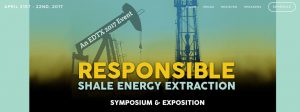 Since 2012 CLEAR has been out and about collecting samples throughout the Barnett Shale and other plays, identifying surface water and groundwater contamination issues that may or may not be directly linked to fracking itself. This is the first time in its history the group has taken on the task of sponsoring a two-day conference. Almost every aspect of unconventional shale mining, or hydraulic fracturing, will try to be addressed.
Since 2012 CLEAR has been out and about collecting samples throughout the Barnett Shale and other plays, identifying surface water and groundwater contamination issues that may or may not be directly linked to fracking itself. This is the first time in its history the group has taken on the task of sponsoring a two-day conference. Almost every aspect of unconventional shale mining, or hydraulic fracturing, will try to be addressed.
Everything is being run out of “The Westminster Abby of Texas,” Fair Park’s own Hall of State. A complete schedule is available here.
Downwinders’ Director Jim Schermbeck appears as part of a roundtable discussion on fracking in general, comparing the perspectives of landowners, gas operators, public health and environmental advocates and scientists. It includes water entrepreneurRichard Seline (AccelerateH20), TRRC Commissioner Ryan Sitton,Laura Buchanan, Executive Director of the Texas Land & Mineral Owners Association , and UTA’s own Kevin Schug.
Maybe you’ll want to come by The Hall of State Friday and mention to Commissioner Sitton how much you dislike the fact that BlueStone wants to put a new injection well on the shores of Lake Arlington. Or show-up on Saturday to see Dr. Hayhoe wow ’em again. But anytime you decide to visit Earth Day Texas, please make sure you come by and say hello to us at the Downwinders table over in the Centennial Building.
“This is the Black Side of Lake Arlington.” Why the BlueStone fracking waste injection well fight is also an Environmental Justice fight
By now you might have heard about the new fracking waste injection well being sought by BlueStone Corporation on the shores of Lake Arlington, the source of drinking water to hundreds of thousands of Arlington residents as well as the cities of Bedford, Colleyville, Euless, Grapevine, and North Richland Hills.
You may know it’s being proposed with a straight face near the Lake Arlington dam, and presents a direct challenge to the municipal bans on such wells that both Fort Worth and Arlington have passed.
But did you know there’s a lakeside public park that’s a longtime social and recreational hot spot for Fort Worth’s Black community just hundreds of feet away? Did you know there are Stop Six residents living adjacent to the proposed well site?
You’d never guess it from the view most of us get out of our cars buzzing by the East Berry exit on Loop 820. Nor can you find it on any of your Internet navigation maps. That’s right, it’s a park and neighborhood so unknown, even Google can’t find it.
But drop by Eugene McCray Park any given weekend and you’ll see a large slice of older Fort Worth black culture, with lots of fishing rods, lawn chairs, and baking brisket. “This is the Black Side of Lake Arlington” says an older gentleman sitting on his tailgate, and a panoramic look around confirms his judgement.
Smaller children energetically utilize the top-o-the-hill playground, older kids and their parents fish from the shoreline, others out in all varieties of boats come and go from the park’s ramp, birthday and anniversary parties roar with laughter from the covered pavilions, customized grills and recipes are carefully tended, dominos are slapped down hard on the cement tables, all surrounded by fresh spring greenery and the lapping waters of the lake. You can watch a heron swallowing a snack, or florescent-necked ducks swimming the small bay that shoulders the park. It’s one giant African-American Norman Rockwall painting. On this March spring day, it’s as though Stop Six has its own miniature all-black Eden in the middle of DFW that no white person can even guess is here.
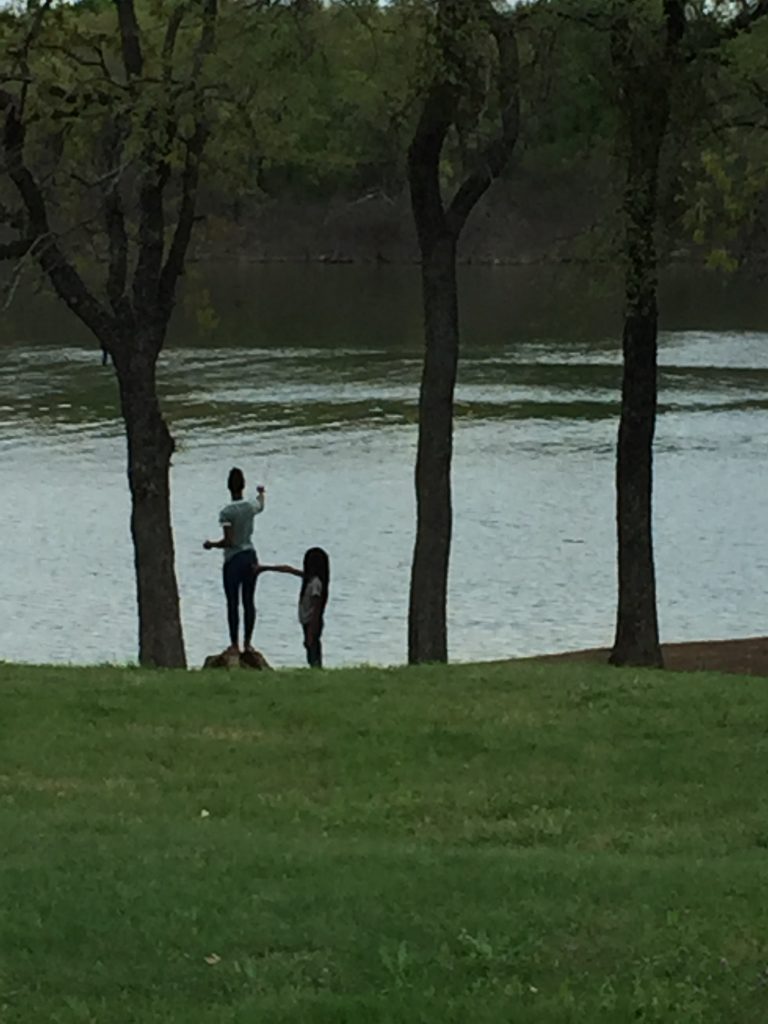 But less than a quarter-mile mile south along this idyllic lake shore is where the BlueStone corporation wants to start disposing of a million and a half gallons of fracking waste a day – in direct violation of a Fort Worth ordinance that says you can’t do that. It’s also the first real challenge to the stalemate frozen in place by 2015’s state law HB40, reining-in the power of cities to regulate oil and gas facilities within their own city limits.
But less than a quarter-mile mile south along this idyllic lake shore is where the BlueStone corporation wants to start disposing of a million and a half gallons of fracking waste a day – in direct violation of a Fort Worth ordinance that says you can’t do that. It’s also the first real challenge to the stalemate frozen in place by 2015’s state law HB40, reining-in the power of cities to regulate oil and gas facilities within their own city limits.
On either side of the well site, neighborhoods are squeezed between 820 and the lake with a mix of low and middle-income renters and homeowners, small lots with gardens, and older ranchettes with horse stalls and chicken coops. McCray Park is their backyard.
Last year BlueStone inherited thousands of local gas wells from belly-up Quicksilver Energy. Right now, the wastes from those wells goes outside the city limits to injection waste wells in other parts of North Texas – places that have had their own problems with their continued operation (like earthquakes, which makes putting a new one by a large dam seem like a bad idea, but we digress….)
But if it had to have a new well – and there’s no proof it did – BlueStone had the pick of any area in Tarrant County or Fort Worth to site this new facility. Nothing in the quotes from the company so far indicate this Stop Six site is an especially strategic or convenient location to ship the wastes from those Quicksilver wells.
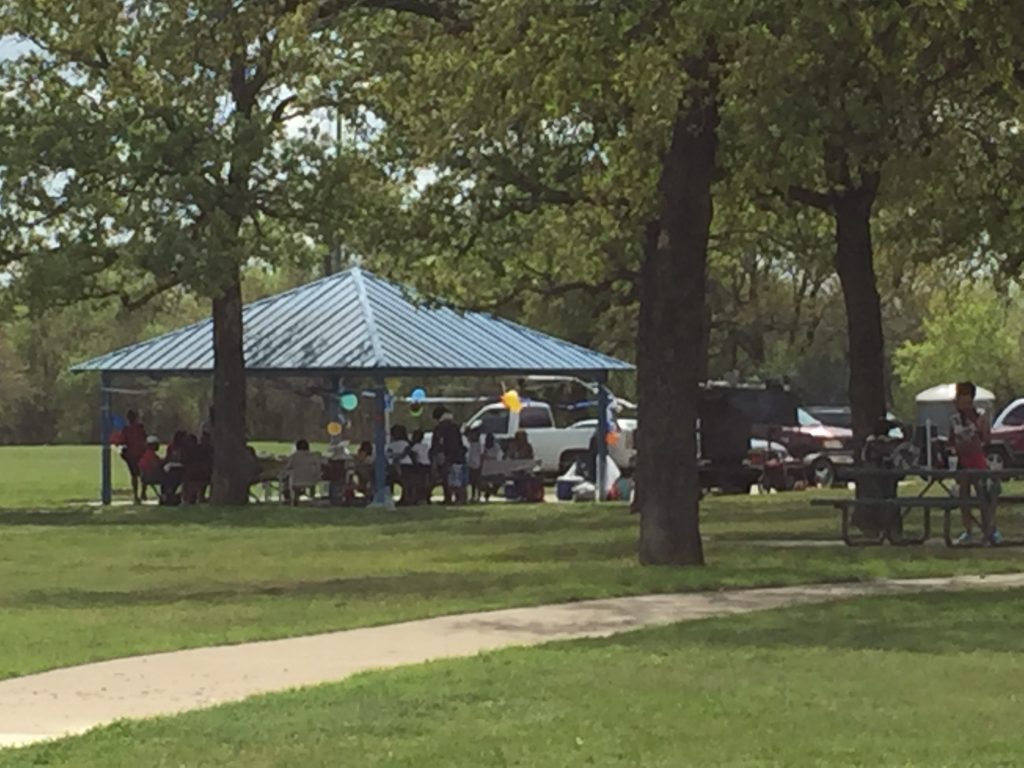 But something about this Stop Six neighborhood does make it a desirable target for a company like BlueStone: It’s predominantly minority and doesn’t have a lot of money to fight back.
But something about this Stop Six neighborhood does make it a desirable target for a company like BlueStone: It’s predominantly minority and doesn’t have a lot of money to fight back.
Does anyone who already has experience in these matters believe it was only coincidence that drove BlueStone to pick this Stop Six site, instead of say, somewhere on the tonier west side? That’s what makes this fight an environmental justice fight along with everything else.
BlueStone has said that its well will only be used for its “nearby” operations. But those operations only produce about half a million gallons of waste a day. Why do they need a permit that allows for disposing of three times that amount? It’s not unusual for a waste well to get a permit under the guise of exclusive use, only to amend the permit a short time later to allow all comers – and charge a nice profit. It also makes it a lot easier to flip in hard times. Unless there’s a deed restriction on this operation, this Lake Arlington site could end up the same way, and the industrial use will overwhelm everything else. The inner-city Black Eden will be gone.
When Downwinders’ staff visited this last weekend, not a lot of the park users were aware of what was taking place just on the other side of the tree line. Given the history and stature of the park – it’s named after a black former city council member and is due to headline new bike and hike trails along the Lake’s west shore – there’s potential for a lot of good organizing in Fort Worth’s black community, and Stop Six in particular, by well opponents. This is as blatant and combustible a combination of race and pollution as recent Barnett Shale Gas Wars have produced.
The area is represented by Fort Worth City Council Member Gyna Bivens, who’s already voted to fight the Bluestone permit, State Representative Nicole Collier, who voted against HB 40 in 2015, and State Senator Konni Burton, a Republican who voted for HB40 while praising Fort Worth’s gas ordinance as a model to be duplicated. That would be the same ordinance now under attack from Bluestone’s pursuit of the well site by Eugene McCray Park.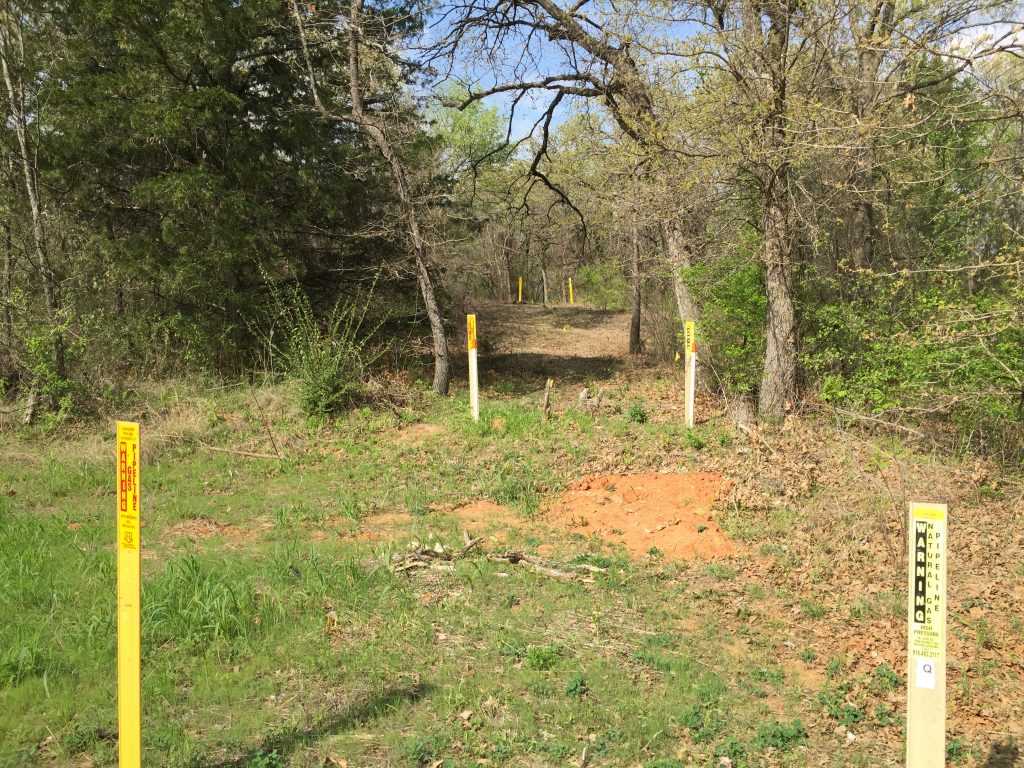
If you haven’t already, you can write in to officially register your opposition to BlueStone’s permit address via our Click N’Send feature. A hearing in Austin at the Railroad Commission offices has been set for May 25th and 26th…..
Raising the potential for earthquakes within distance of a large, important dam,
Potentially poisoning drinking water for a large chunk of the Metroplex,
Spills and accidents causing fish kills and other wildlife harms
Larger and larger emissions threatening breathers downwind,
Ignoring local ordinances and the rule of law,
There were already plenty of good reasons to oppose the BlueStone injection well. Now there’s another.
The First Step to Opposing a new Disposal Well on the Shores of Lake Arlington is Just a Click Away
Today, we officially announced our hiring of Anthony Gonzales as a second Downwinders staffer. One of the reasons we need additional personnel is to help fight off the kinds of new challenges that a Trump presidency will encourage. Exhibit A: The Bluestone Natural Resources Corporation permit to open a disposal well for their fracking wastes on the shores of Lake Arlington, the major source of drinking water for the city of approximately 350,000 people.
Since the passage of the notorious HB 40 in 2015 by the State legislature that substituted state control over local zoning in regulating oil and gas operations within city limits, no Texas municipality or gas industry operator has challenged the uneasy status quo that was in place when the law was signed…until now.
In 2012, after rounds of concern about earthquakes and industrial contamination Fort Worth banned the siting of disposal wells within their city limits – a bold move for a municipality that openly embraced the fracking boom.
But when HB40 was passed by the State Legislature in 2015, local regulations like Cowtown’s disposal well ban had to have been in place for five years to be commercially acceptable. Bluestone applied for its permit less than six months before that five year period was up.
Last year Bluestone bought out Quicksilver and all of its Barnett Shale wells. Instead of continuing to use existing wells outside the city limits, Bluestone wants the convenience of dumping in town. Its permit requests permission to inject up to 1,250,000 gallons of fracking waste PER DAY into the well. Here’s a Channel 11 report on the controversy.
Both the cities of Fort Worth and Arlington have filed formal protests to the permit request. We need EVERY local, state, and federal elected official representing the area to do the same.
Meanwhile, you can join the chorus of opponents by simply sending an email down to Austin.
Use our Featured Citizen Action Click N’ Send System to let Austin Know You Oppose This Permit
A simple letter like the one below is ready to go once your contact information is plugged in….All you have to do is click
….or send your own comments opposing the well
to the Texas Railroad Commission at this address:
Juanita.jimenez@rrc.state.tx.us
Here’s a sample letter.
Dear Ms. Jimenez,
I am writing to protest the permitting of Bluestone Natural Resources wastewater disposal well
with Tracking Number 46045 in Newark, East Field for Cravens Lease, Well Number1.
Your Full name
Your complete Address
______________________________________________________
Don’t Delay. Make Sure They Feel the Push Back in Austin.
To keep track of developments about this disposal well permit, please check out the FaceBook page of local environmental group Liveable Arlington.
Meet Anthony Gonzales, the First New Staffer at Downwinders in a Decade. Now Help Us Keep Him.
 There's a slew of changes coming as a result of decisions made at the Downwinders' board retreat with Lois Gibbs last month. Among them:
There's a slew of changes coming as a result of decisions made at the Downwinders' board retreat with Lois Gibbs last month. Among them:
New redesigned website
New updated logo
New presence on social media
New year-round events calendar for supporters
New campaigns and projects
New board members
As a commitment to this make-over, Downwinders is pleased to announce its first new staff hiring in ten years: Anthony Gonzalez is a Mansfield resident and UTA Junior in History. He ran for Mansfield City Council when he was 18…and lost. He's currently enrolled in Downwinders' College of Constructive Hell-Raising and works part-time for the City of Arlington Department of Environmental Services. Anthony has been hired as our very first Program Assistant to help Downwinders' Director Jim Schermbeck in modernizing our data base, assist in communications work, and coordinate new volunteer outreach and events.
This means for the first time since it's founding, Downwinders has two people on staff at the same time to help us fight for your lungs.
With this new growth comes new responsibilities. We have donations to cover Anthony's part-time job until the beginning of summer. We need your help to keep him employed year round from now on.
In its decision to hire Anthony, the all-volunteer Downwnders' board made a down payment on our future. Can you show your good faith and return the favor?
Lois Gibbs is Coming Back to Dallas – to Help Downwinders Plan and Strategize
 Imagine Rosa Parks personally leading a strategy and planning session for your local civil rights groups. Or Ralph Nader coming to spend a weekend with your consumer rights groups to help you prioritize your goals.
Imagine Rosa Parks personally leading a strategy and planning session for your local civil rights groups. Or Ralph Nader coming to spend a weekend with your consumer rights groups to help you prioritize your goals.
That's the enviable position Downwinders at Risk's all-volunteer board is in after finding out Lois Gibbs, the mother of the modern American environmental movement, will be their facilitator in a weekend-long retreat this coming weekend…for free.
It seems one of the few perks of becoming a board member for Downwinders is being able to call on America's #1 toxic avenger for help when you need her.
Gibbs and Downwinders go back almost 25 years, by way of our founder, Sue Pope, and our Director, Jim Schermbeck. Gibbs was the featured guest at our very first Root and Branch Revue in 2015. Besides getting her entire community relocated off a toxic waste dump, and building the Superfund clean-up program from scratch to address the contamination at sites like hers, Gibbs also founded the The Center for Health, Environment & Justice, the largest grassroots environmental network in the country. She brings decades of organizing experience and a national perspective to the Downwinders program work in DFW.
From this Friday through Sunday, the entire Downwinders board and staff will be meeting out of town to discuss what it means to be a local clean air watchdog in the Age of Trump. We had lots of good conversations over the course of this year's just-concluded Root and Branch Revue that we'll be following-up on. We'll also review all the recommendations left on our "What If" Wall" that made the rounds of Root and Branch events. We asked everyone who showed-up to write down what they needed to happen. We got a wheelbarrow of ideas, all of which are being considered by our board, including:
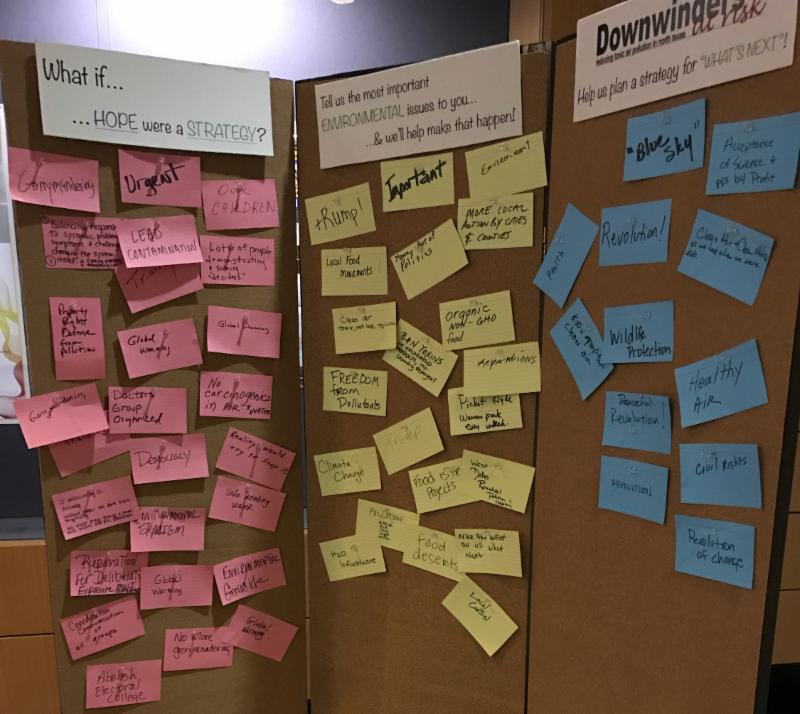
"Getting a doctors/nurses groups organized"
"Getting a children's group organized"
"More coordination and communication among groups"
"Using new technology to do environmental testing"
"Getting cities to better address climate change"
"Better connecting food policy to environmental policy"
"Systematically addressing environmental racism/justice"
"Linking local targets to national campaigns"
A Trump Administration means that our hopes for a sane DFW clean air plan are gone. What they get replaced with is up for grabs although we have some promising ideas that we hope Lois can help us sort through. We made great new allies over the past month. We've made some alarming discoveries that deserve more attention. We need to adjust our plans to suit the new times. We'll be reporting back soon with our results. Stay tuned.
2017 R&B in pics
Scientists, Officials, and Activists: All in One Day
One- Day University of Change
Tomorrow – Saturday Jan. 28th
Two tracks of workshops going on all day
9:30-5:50
Walk-Ups Welcome
$35 for workshops plus lunch
$20 for students
Bluebonnet Ballroom, UTA Univ. Center
300 West First Street, Arlington
It only happens once a year
Flint Water Protectors!
Local Elected Officials in a Q&A!
Drones!
Lawyers! Scientists! Activists!
SCHEDULE
9:00- 9:30 am Morning Registration
9:45-10:45 am
Classroom #1
The Dos and Don't of Citizen Health Surveys
Leslie Allsop, University of Texas Health Science Center Classroom
Classroom #2
Using Science to Make Violations Stick
Tamera Bounds, Mansfield Gaswell Awareness and Downwinders at Risk, with Ranjana Bhandari of Livable Arlington
11:00 am – 12:00 Noon
Classroom#1
Citizen Monitoring of Drinking Water
Doug Carlton of UTA's C.L.E.A.R.
Classroon #2
State of the Air – An Asthma Forecast
Shammara Norris, Asthma Chasers
LUNCHTIME FORUM
12-1 pm
Catered Lunch
Local elected officials talk about protecting their quality of life goals in the face of state and federal opposition
Dallas County Commissioner Theresa Daniel
Dallas City Council Member Sandy Greyson
Fort Worth City Council Member Ann Zedah

1:15 -2:15 pm
Classroom#1
Fighting Environmental Permits in Texas
Ilan Levin, Attorney, Environmental Integrity Project
Classroom#2
Petition Rights: The Source of Citizen Power to Take Back Their Towns
Linda Curtis, Independent Texans
2:30 – 3:30 pm
Classroom#1
Strategy vs Tactics
Jim Schermbeck, Downwinders at Risk
Classroom#2
Door-to-Door Outreach
Corey Troiani, Texas Campaign for the Environment
3:45 – 4:45
Classroom #1
High Tech Tools for Citizens
Dr. David Lary, University of Texas @ Dallas, Doug Carlton, University of Texas @ Arlington, Jim Schermbeck, Downwinders at Risk

Classroom #2
How Flint was Exposed
Melissa Mays, Water You Fighting For and Nayyirah Shariff, Flint Rising
5:00 – 5:30
Air Sampling and Monitoring Drone Demonstration (weather permitting)

5:30
Happy Hour Networking
REGISTER HERE NOW
OR WALK-UP ON SATURDAY
(It's a secure Click and Pledge pay portal established just for this event, so the $35 registration is called a "donation." Just click on the $35 button and fill out the credit card info and you're done)

